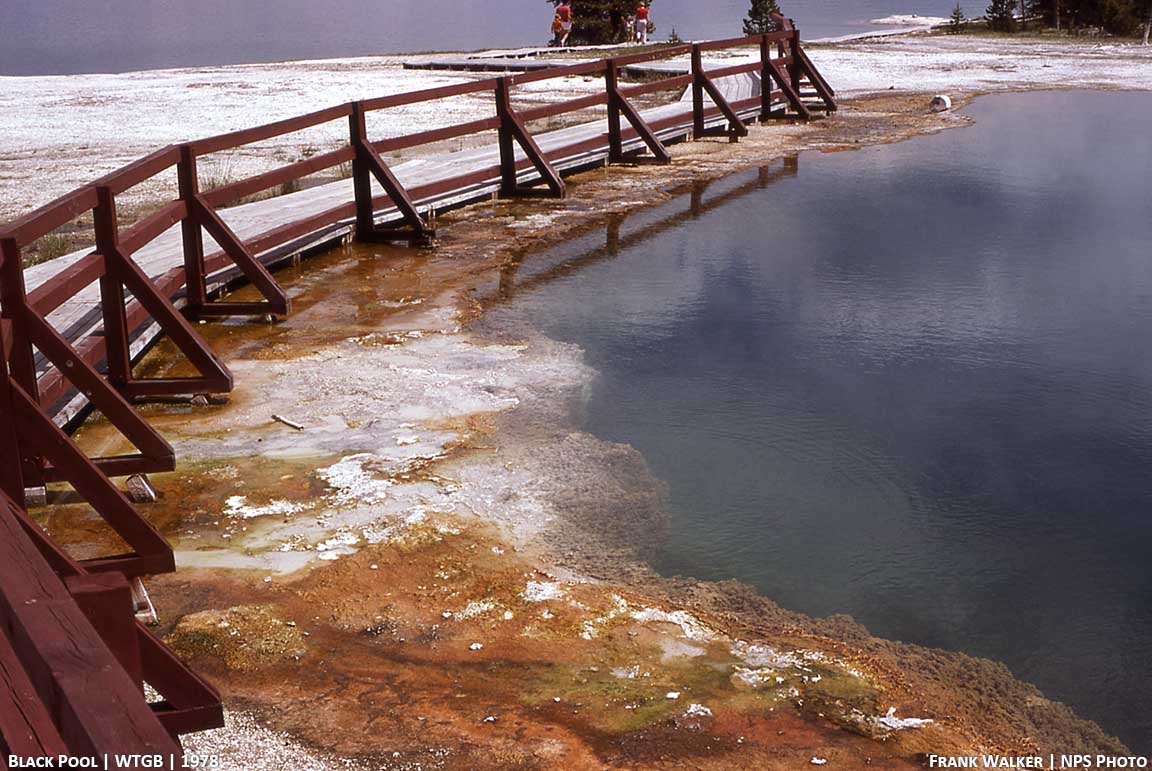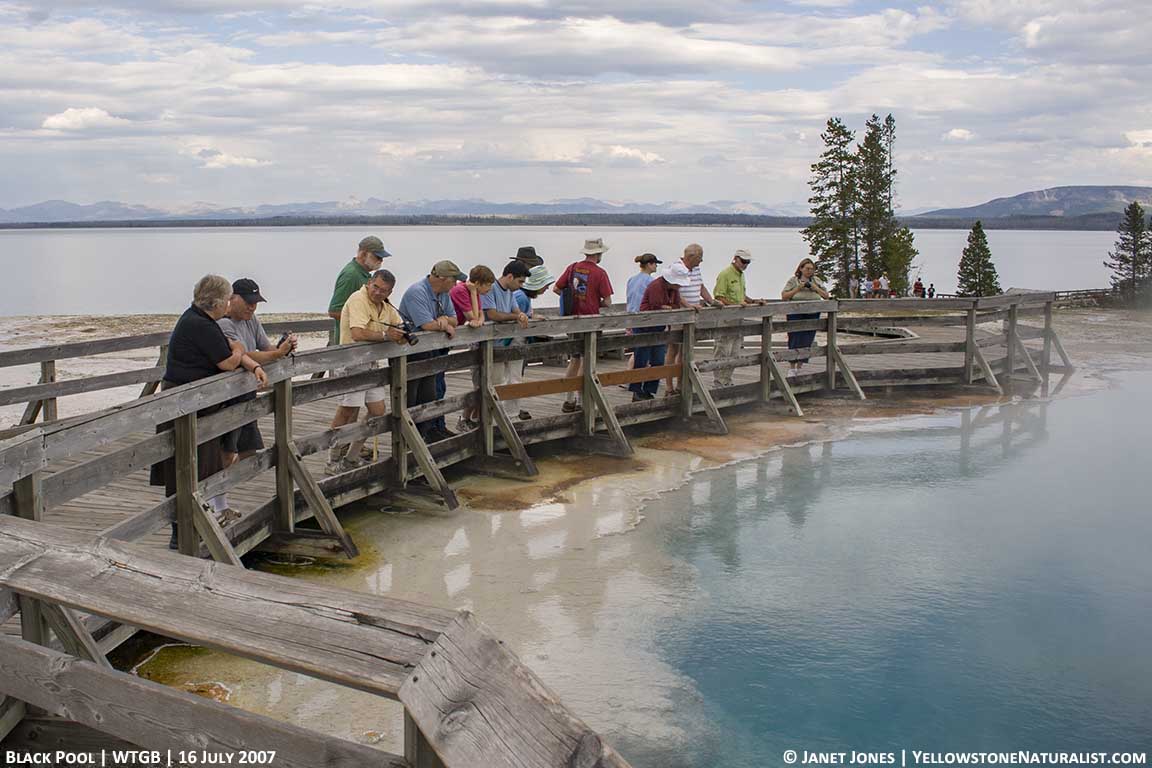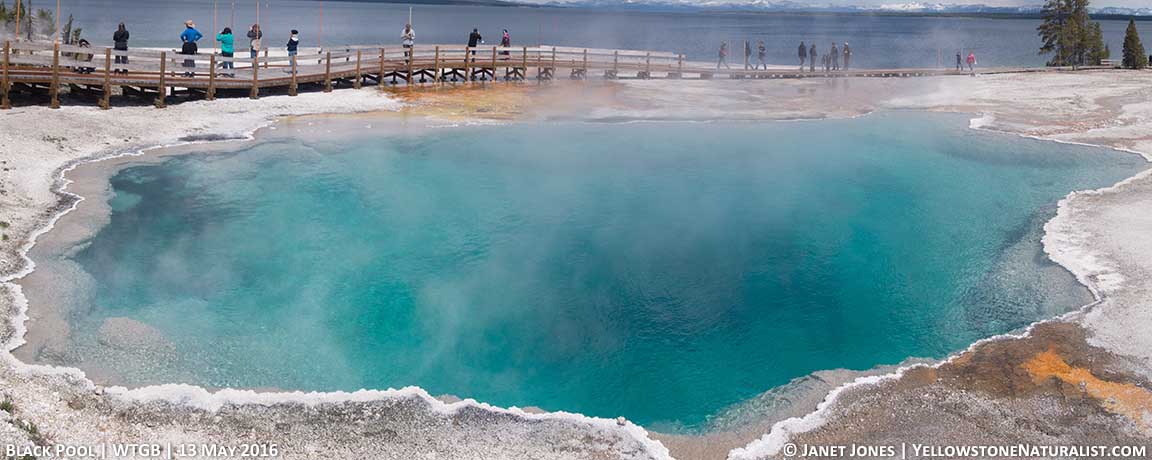Why is it called Black Pool when it’s blue?
One of the most often asked questions at West Thumb Geyser Basin is, “Why is it called Black Pool when it’s blue?”
This NPS photo from 1978 shows how it used to look, which is black. The microbes lining the surface of the crater were said to be a dark orange or brown that you can also see in this photo. Blend that color with the blue you normally see with water and you get this inky black or a deep green.
SHORT VERSION
In August 1991, a new vent opened up, and joined with Black Pool. This hotter water killed off the microbes, allowing us to see the water’s color with just the gray sinter (rock) as a background rather than the dark orange microbes.
LONGER VERSION OF HOW AN ENERGY SHIFT CREATED THIS CHANGE
Black Pool was true to it’s name since the early days of the park with one report in 1950 of a time when it heated up enough to kill the microbes, reportedly due to the overflow from a hot spring just uphill from Black Pool.
In 1978, Marlene Wassman reported that “new little vents appeared on the lake side of Black causing a killing off of algae [microbes] for about 3-4 feet around, the pool cleared a little and it is possible to see down 10-12 feet; color is a dark blue.” This is what the NPS photo illustrates.
Assuming the next observation from May 1979 also talks of this same area, “Most notable change was the birth of a new hot spring at the edge (by the boardwalk) of Black Pool. It measured about 200º F and was just noticed on June 12…”
By 1984, there was a reference to a “northwest edge crack” that Jeff Selleck says “emitted more gas than last year.”
By 1987, Roger Anderson figured an average winter temperature for Black Pool of 79º F. Carol Shively mentions the average winter temperature in 1988 was 144º F. Quite the shift over a year’s time, and the start of the energy shift that resulted in the eruptions that opened up Black Pool as well as eruptions seen in Abyss Pool.
Carol Shively noted in the winter of 1989 that Black Pool “is clearer than it has been in over two years, about 1/3 of cavern is visible.” Also at that time, Black Pool received runoff from Twin Geyser and Roadside Steamer.
Roger Anderson then noted: “Beginning in Feb 1990, Black Pool has appeared clearer, with the pool’s depth more visible than it has in the recent past.”
A report in the log book by D.B. said that “along the edge of the pool near the corner of the boardwalk there are very small Springs (very hot) located on shelf. The volume of water and intensity of boiling has increased substantially. It appears to me there is a fracture along with these springs we located and the fracture may be widening. If so, a rather large piece of the rock lining the pool will soon break away and fall into the pool.”
By June 1991, a “new Spring on rim” was noted to be 199ºF (the temperature of boiling water at this altitude) and by July 5 was 203ºF (superheated – or hotter than boiling temperature).
On August 15, 1991 an eruption took place that completed the opening of the vent now clearly visible from the viewing platform. The actual eruption was not witnessed as far as is known.
Allan Friedman reported in a GOSA Transactions article on this incident that a ranger who told him about the springs said that “those springs [along the north edge of the pool] were no longer visible. He witnessed more eruptions over 2 feet high and 3 feet wide as well as periods of heavy boiling and overflow.
After the eruption, the pool was a gray-brown and took a couple of days to start clearing.
Below is a photo taken from a similar angle as the NPS photo above that shows the difference after the eruption opened up the new vent in 1991. And a panoramic photo of Black Pool from the current viewing platform that gives a good view into the 1991 vent.
References: A History of West Thumb by Rocco Paperiello | GOSA Transactions Vol 3 – Eruptive Activity by Black Pool, August 15, 1991 by Allen Friedman | West Thumb Thermal Log 1988-1995


